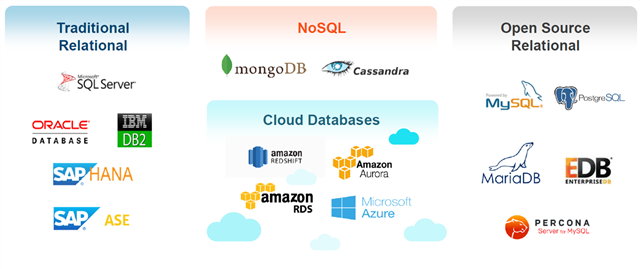Hey look, an Amazon Cloud!

To recap,
Part 1 covers 'As A Service' (...aaS) options - https://www.quest.com/community/blogs/b/performance-monitoring/posts/are-your-database-implementations-becoming-a-bit-cloudy-part-1-3-part-series-aas-the-world-turns
Part 2 reviews Microsoft cloud flavors - https://www.quest.com/community/blogs/b/performance-monitoring/posts/aaaaaazure-bless-you-part-2-of-3
In this final blog of this 3-part series, a few (of many) Amazon AWS offerings/services are reviewed.
More specifically, the three types of Amazon cloud products discussed here are RDS, Aurora, and RedShift.
Know there many other cloud solutions from Amazon AWS...too many to cover in detail in this blog...EC2 (Elastic Compute Cloud) - IaaS, S3 (Simple Storage Service) - Cloud data storage, DynamoDB - NoSQL cloud database...and so on...
RDS (Relational Database Service):
RDS is a cloud service (DBaaS) provided by Amazon Web Services (AWS).
It offers support for six database engines including Microsoft SQLServer, Oracle, Postgres, MySQL, MariaDB, and Aurora
RDS advantages include:
Administration - There is no installation or set-up necessary. Several tasks are automated including patching and backup and recovery.
Availability - Replication is included and there is automatic failover.
Scaling - CPU, Memory, and Storage can be independently modified as needed.
Security - Elevated privileges are required and shell commands are prohibited.
Common complaints about RDS include cost and access to low-level features/tasks.
Aurora:
As mentioned above, Aurora is a relational database engine developed by AWS specifically for cloud deployments. Aurora attempts to strike a balance between the power of the enterprise-level databases and the flexibility and low cost of open source solutions.
Aurora advantages include:
Availability - Across 3 'Availability Zones' 6 copies of data are replicated. Continuous data backups are taken to Amazon S3.
Compatibility - Aurora supports both Postgres and MySQL for easier migrations to the cloud.
Performance - Up to 5x the throughput for MySQL and up to 3x the throughput for Postgres (versus standard deployments)
Redshift:
Redshift is an AWS cloud data warehouse. It is a column-oriented database used with BI solutions for dataset storage and analysis.
Interestingly, Redshift's name is said to have spawned from the idea of "shifting away" from Oracle. (Oracle's brand color is red and they are sometimes referred to as 'Big Red'.)
Redshift advantages include:
Performance - Using two architectural elements, columnar storage and 'Massively Parallel Processing' (MPP), the workload is distributed across nodes for fast processing of 'massive' amounts (petabyte+) of data.
Scalability - Based on performance or capacity needs, Redshift can scale up or down 'on the fly' versus traditional costly hardware investments and time-consuming (re)deployments.
Quest is known for its IT infrastructure software....helping companies "solve complex problems with simple solutions". The Quest portfolio of software offers efficiencies with development, administration, security, as well as monitoring and diagnostics (and much more).
To tie this 3-part blog series together, if you have needs around monitoring the availability, performance, and operational tasks of your growing and ever-changing database environment, consider Foglight for cross-platform databases.
Foglight can monitor and diagnose traditional relational databases, open-source databases, and NoSQL databases...on-prem or in the cloud...be it IaaS or DBaaS.
Foglight Monitoring Support:
(Click on image to enlarge)

For more information, visit Foglight database monitoring and download a free trial.


